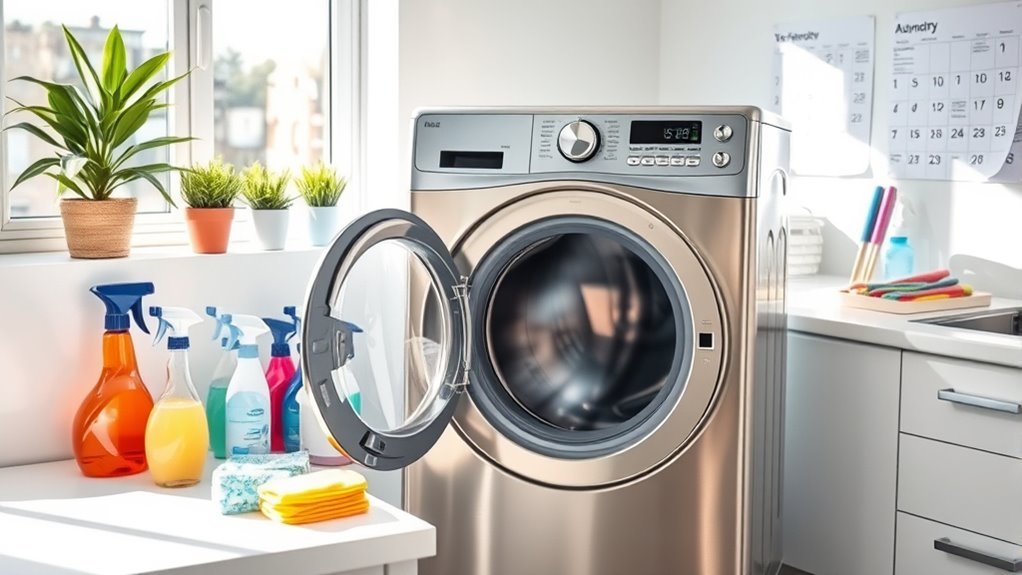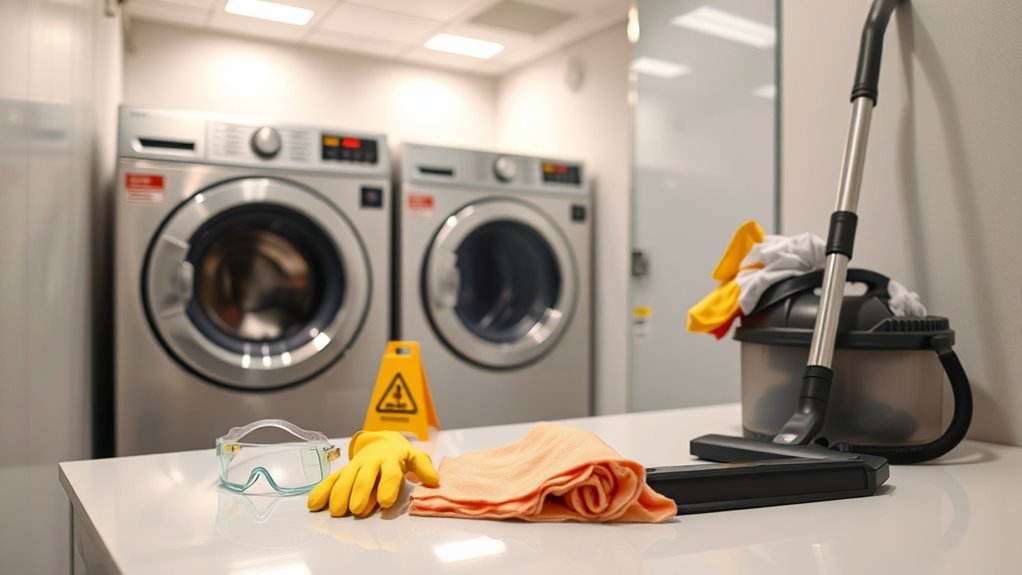How to Clean Dryer in Office Spaces
You should regularly clean your office dryer’s lint trap by removing visible lint and washing it with warm water to keep air flowing efficiently. Unplug the dryer before cleaning, use a vacuum and flexible brush for vents, and wipe the drum and exterior with a mild detergent. Watch for longer drying times or unusual noises—signs it may need professional maintenance. Keeping up with these steps reduces fire risks and energy costs. Discover more ways to maintain your dryer’s peak performance.
Importance of Regular Dryer Cleaning in Offices

Although you might not think about it often, regular dryer cleaning in office spaces is essential to maintain safety and efficiency. Neglecting this task increases fire hazards due to lint buildup, which can ignite under heat. You’re not just protecting equipment—you’re safeguarding everyone’s well-being by reducing health risks linked to dust and allergens circulating in the air. A clean dryer runs more smoothly, cutting down on energy consumption and preventing costly repairs or downtime. Staying proactive with dryer maintenance means you avoid unexpected disruptions and maintain a safe, healthy environment. By prioritizing regular cleaning, you take control, ensuring your office remains a secure space where productivity and freedom aren’t compromised by preventable hazards.
Tools and Materials Needed for Dryer Cleaning
You’ll need a few essential cleaning supplies like a vacuum with a hose attachment, a microfiber cloth, and a dryer vent brush to get the job done effectively. Don’t forget safety equipment such as gloves and a dust mask to protect yourself from debris and allergens. Having the right tools on hand makes the cleaning process safer and more efficient.
Essential Cleaning Supplies
A few essential tools and materials make cleaning a dryer in office spaces efficient and thorough. To tackle lint buildup effectively, you’ll need a vacuum with a narrow nozzle to reach inside vents and ducts, a flexible brush designed for dryer vents, and microfiber cloths for wiping down surfaces. Use a mild detergent mixed with water to clean the drum and exterior. Avoid harsh chemicals that could damage components. Mastering proper drying techniques means ensuring airflow isn’t obstructed, so clear all lint traps and ducts regularly. Having these supplies on hand lets you maintain peak dryer performance, prevent fire hazards, and extend the appliance’s lifespan. With the right tools, you’ll keep your office dryers running smoothly without hassle or downtime.
Safety Equipment Required
Before you begin cleaning a dryer in office spaces, it’s crucial to equip yourself with the right safety gear to protect against dust, debris, and potential electrical hazards. Start with safety goggles to shield your eyes from lint particles and any accidental sparks. Next, wear protective gloves to guard your hands from sharp edges inside the dryer and to avoid skin irritation from dust or cleaning agents. Consider a dust mask if the environment is particularly dusty. Make sure your clothing covers your arms to prevent scratches. Proper footwear is also important to avoid slips or injuries when moving heavy parts. By using these safety essentials, you’ll keep yourself secure and maintain efficiency while cleaning, ensuring the job gets done thoroughly without risking your well-being.
Safety Precautions Before Starting the Cleaning Process

Since dryers involve electrical components and lint buildup that can pose fire hazards, you need to prioritize safety before starting the cleaning process. First, always unplug the dryer to eliminate any risk of electric shock. Be aware of common cleaning hazards like sharp edges inside the machine and dust particles that can irritate your respiratory system. Ascertain proper ventilation in the area to avoid inhaling lint or debris. Avoid using water or wet cloths near electrical parts to prevent short circuits. Wear protective gloves and a dust mask to shield yourself from irritants. Finally, check the dryer’s manual for any specific safety instructions. Sticking to these dryer safety precautions helps you clean confidently and keeps your office environment safe and hazard-free.
Step-by-Step Guide to Cleaning the Dryer Lint Trap
Now that you’ve prioritized safety, the next step is tackling the dryer lint trap. Start by locating the lint trap, usually positioned on top or inside the door frame. Pull it out carefully and remove all visible lint with your fingers or a soft brush. For thorough lint trap maintenance, rinse it under warm water to clear residual buildup, then let it dry completely before reinserting. Regular cleaning of this component is essential because lint accumulation hinders dryer efficiency, increasing drying times and energy use. Make it a habit to clean the lint trap after every use to maintain ideal airflow and prevent fire hazards. This simple routine preserves your freedom from costly repairs and keeps your office dryer running smoothly and safely.
How to Clean the Dryer Drum and Exterior Surfaces

Cleaning the dryer drum and exterior surfaces is an essential step to keep your office dryer functioning efficiently and looking professional. Start with drum cleaning by wiping the interior with a soft cloth dampened with mild detergent and warm water. Avoid harsh chemicals that could damage the drum’s surface. Make sure to remove any residue or lint buildup to prevent odors and maintain peak drying performance. Next, focus on exterior polishing. Use a non-abrasive cleaner suitable for your dryer’s finish to remove smudges and dust. Buff with a microfiber cloth to restore shine and give your dryer a polished, well-maintained look. Regular drum cleaning and exterior polishing not only extend the dryer’s lifespan but also promote a clean, inviting office environment.
Cleaning the Dryer Vent and Ductwork
Keeping the drum and exterior spotless helps your dryer look great and work well, but paying attention to the vent and ductwork is just as important. Regular ventilation maintenance prevents lint buildup, reducing fire hazards and improving efficiency. Start by disconnecting the dryer and detaching the vent hose. Use a vacuum or dryer vent brush to clear lint from both the vent and ductwork thoroughly. Don’t skip a duct inspection; check for cracks, blockages, or damage that could restrict airflow. Ensuring your ducts are clean and intact helps your dryer run smoothly, saves energy, and extends its lifespan. Make ventilation maintenance part of your routine cleaning schedule, giving you freedom from unexpected breakdowns and keeping your office environment safe and efficient.
Signs of Dryer Maintenance Issues to Watch For
If you notice your dryer taking longer than usual to dry clothes or hear unusual noises during operation, these could be early signs of maintenance issues. Clogged vents are a common culprit, restricting airflow and causing the dryer to overheat or work inefficiently. Pay attention to any rattling, squeaking, or banging sounds—they often indicate worn parts or blockages that need immediate attention. Ignoring these signs can lead to higher energy costs and potential safety hazards. Regularly inspecting your dryer for such symptoms helps you stay ahead of costly repairs and downtime. Stay vigilant for these warning signals to guarantee your office dryer runs smoothly, maintaining both efficiency and safety without compromising your freedom to focus on what matters most.
Tips for Maintaining Dryer Efficiency in Office Environments
To keep your office dryer running efficiently, make certain you clean the lint trap after every use—this prevents blockages and reduces fire risks. You should also schedule regular checks of the ventilation system to guarantee proper airflow and avoid overheating. Staying on top of these tasks will extend your dryer’s lifespan and save energy.
Regular Lint Trap Cleaning
Although it might seem like a small task, regularly cleaning the lint trap is essential to maintaining your office dryer’s efficiency and safety. Neglecting lint trap maintenance can reduce dryer performance, increase energy consumption, and even pose fire hazards. You should remove the lint trap after every drying cycle and clear out all lint buildup. Use a soft brush or vacuum attachment to reach stubborn debris. Consistent cleaning guarantees proper airflow, allowing the dryer to operate effectively without overworking its components. This simple habit saves you time, reduces repair costs, and keeps your office environment safe and efficient. Make lint trap cleaning a routine part of your office maintenance plan to enjoy reliable dryer performance and peace of mind.
Ventilation System Checks
One key step in maintaining your office dryer’s efficiency is performing regular ventilation system checks. Ventilation system maintenance guarantees that your dryer’s airflow efficiency remains ideal, preventing overheating and reducing energy consumption. You should inspect the vents and ducts for blockages, lint buildup, or damage, as these can restrict airflow and impair drying performance. Use a vacuum or brush to clear debris and schedule professional inspections periodically to catch hidden issues early. Keeping your ventilation system in top shape not only extends your dryer’s lifespan but also enhances safety by minimizing fire risks. By prioritizing these checks, you maintain smooth operation and enjoy the freedom of a reliable, efficient dryer in your office space.
Frequently Asked Questions
Can Office Dryers Be Used for Personal Laundry?
You might wonder if you can use office dryers for personal laundry. It really depends on your office policies—some allow it, others don’t. To avoid conflicts, always check those guidelines first. Practicing good laundry etiquette is key: don’t monopolize the machine, and keep it clean for others. Respecting these rules guarantees everyone enjoys freedom and convenience without issues or misunderstandings in shared spaces.
How Often Should Professional Dryer Maintenance Be Scheduled?
Oh, sure, wait until your office dryer bursts into flames before thinking about dryer maintenance frequency. But if you prefer freedom from unexpected disasters, schedule professional maintenance at least twice a year. The benefits of scheduling include improved efficiency, longer appliance life, and reduced fire risks. Regular checkups keep your dryer running smoothly, saving you time and money, so you can focus on your work instead of emergency repairs.
What Is the Average Cost of Dryer Repair in Offices?
When considering repair costs for dryers in office spaces, you’ll find the average ranges between $150 and $400, depending on the issue. Knowing the average lifespan of your dryer—usually 8 to 12 years—helps you decide if repairing is worth it or if replacement makes more sense. Keeping tabs on repair costs versus lifespan guarantees you maintain efficient equipment without overspending or losing freedom to unexpected breakdowns.
Are There Eco-Friendly Dryer Cleaning Products Suitable for Offices?
Imagine your dryer as a garden needing care without harsh chemicals wilting its leaves. You’ll find eco friendly solutions like plant-based sprays and biodegradable wipes that keep it running smoothly. These sustainable products protect both your machine and the planet, letting you maintain a clean office environment freely and responsibly. Choosing them means you’re not just cleaning—you’re cultivating a healthier workspace with less environmental impact.
Can Dryers Cause Fire Hazards in Office Buildings?
Yes, dryers can cause fire hazards in office buildings if you’re not careful. The biggest risk comes from lint buildup, which can easily ignite without proper fire prevention measures. You’ll want to regularly clean lint traps and vents to keep airflow clear and reduce fire risk. Staying proactive guarantees safety and keeps your workspace running smoothly, giving you the freedom to focus on what matters most.






